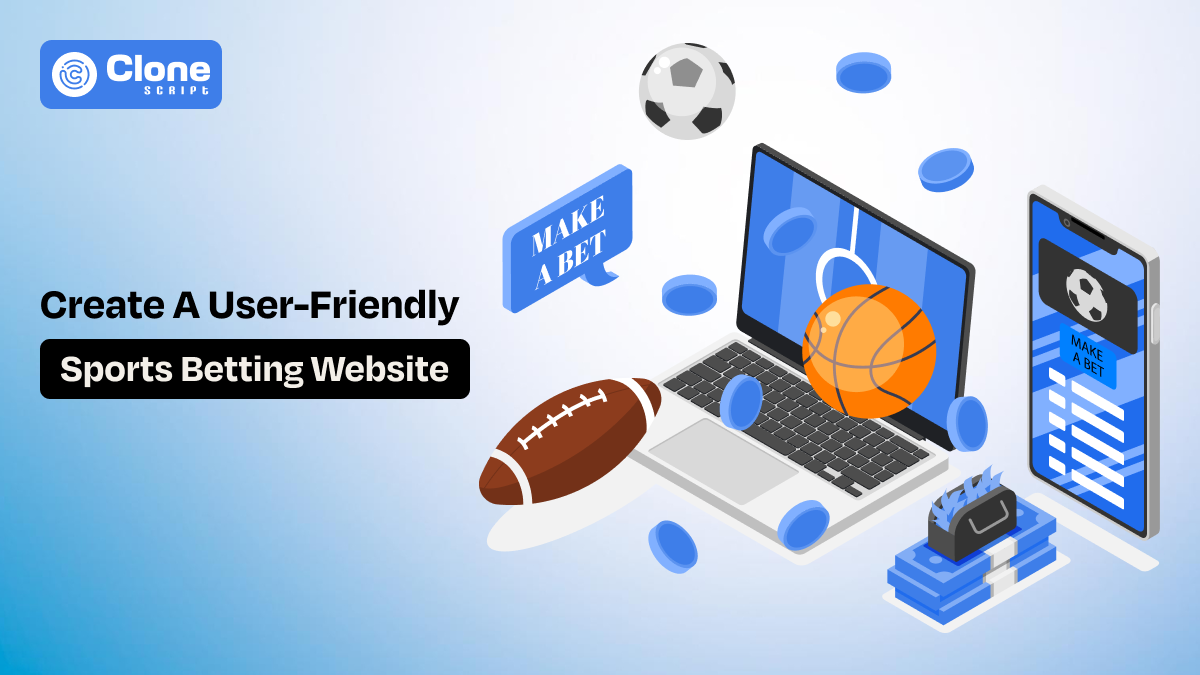How to Design a User-Friendly Online Sports Betting Website
Honestly, building a sports betting website in today’s digital world is just like climbing a mountain in the heavy rain. But it’s not impossible.
How?
You have to follow the proven tips to make web development safe, smooth, and streamlined. The best part is that you can do it all without compromising the quality.
As we know, today’s bettors need a secure website that loads fast, sounds professional, and maintains the expectations they have.
Being a developer, you’re doing beyond just building features like betting and payment deposits. You’re designing the flow, the mood, and the moments that keep users coming back.
Every click, scroll, and tap should feel natural. Every page should load like it’s reading your mind.
So how do you bring all of that together? How do you build a sports betting platform that doesn’t just work, but wins? This guide is your playbook. You will know sportsbook UX fundamentals, tips for best design, conversion strategies, practices that convert, and real-world examples that spark ideas.
Why UX Matters in a Sports Betting Website?
Four elements indicate that the betting site has to be the best user experience, not just to outrank competitors but to win the trust of users. Those elements are as follows:
-
User Retention: A bettor who enjoys their first experience is far more likely to return. Through clean navigation, logical layout, and fast transactions, you can retain them.
-
Speed Matters: In live betting scenarios, every second counts. Your site needs to get real-time data updates and give immediate responses to users for taking action.
-
Trust and Credibility: A well-optimized sports betting UI design signals professionalism and security at every stage. It reflects visible licensing, reliable payment methods, and clear odds, a foundation for trust.
-
Device Accessibility: Most users today access sportsbooks via mobile. A mobile-first sports betting website design validates that the UX is flawless, regardless of device size.
Users want to make informed decisions quickly and place bets without frustration. If a platform is confusing, slow, or clunky, they go elsewhere. But it can be fixed by following UX best practices for betting.
Keep in mind: Your users won’t tolerate obstacles. You have a small window to impress and even less time to guide them toward action.
Key Design Elements for a User-Friendly Betting Platform
To create a genuinely professional sports betting website, you need to address every layer of the user experience. This includes everything from information structure to how easily someone can place a bet with one hand on a smartphone.
1. Mobile-First and Responsive Design
As most of the users love to play betting contests on their smartphones, a responsive website is a non-negotiable. Why? Through the mobile-friendly screen optimization, the website loads quickly and is rarely stuck in a live competition.
This results in a higher engagement rate and, of course, a brand precision reward to you.
But what signs of a responsive website design? Here’s the checklist:
-
Prioritizing core functionality in small screen layouts
-
Placing buttons like “Place Bet” within thumb reach
-
Making navigation collapsible but accessible
Start with mobile wireframes, then scale upward. This forces clarity and focus at every stage of design.
2. Clean, Predictable Navigation
The successful betting platforms like 1xBet and Dafabet have become popular due to not their PRs and marketing, or even their advanced features. These contribute more to their achievements.
But another thing also makes a more significant contribution: it’s the navigation on their website.
Think as a better person; you don’t want to lose yourself in the sea of information to place a bet in a live cricket competition.
So what does it mean? To drive engagement and help make the preferred action.
Follow these tips to design the betting website navigation.
-
Keep menus simple, categorized by sport, league, and live events; it’s an ideal option to drive engagement.
-
Use icons that resonate universally, like balls, clocks, and trophies, to make things even more scannable.
-
Breadcrumbs, sticky headers, and smart search also improve navigation. A user should be able to go from the homepage to placing a bet in under 30 seconds.
You can take the help of a professional website UI/UX designer to keep everything on point and reduce the chances of losing users.
3. Real-Time Data Integration
Users who want to bet on live and upcoming contests need real-time data to judge the best results. It means fetching the correct data is non-negotiable.
As odds fluctuate, especially during live matches, you have to move towards backend development. Use WebSockets or polling APIs for your odds and scores to update instantly. Highlight changing odds with tiny animations to draw attention without being confused.
4. Intuitive Bet Slip Design
The bet slip is the centerpiece of conversion, and it plays a key role in encouraging players to spend more time. A winning design includes:
-
Auto-populated Fields: When users select a bet, the bet slip should instantly populate with relevant information such as teams, odds, and event details.
-
Instant Potential Payout Calculations: As soon as users enter their stake, the system should automatically calculate probable winnings in real-time.
-
Easy Switching Between Single, Combo, and System Bets: Users should be able to toggle between single, combo (parlay), and system bets without re-entering data.
-
Fast Editing and One-click Submission: This allows users to quickly adjust stakes, remove selections, or submit bets with one click. To keep the flow smooth and increase the likelihood of finalizing bets quickly, it is required.
-
Persistent, Accessible Design: The bet slip should remain easily accessible across all pages. Either docked in the interface or as a slide-out drawer. From there, users can view, edit, or place bets at any time.
5. Visual Hierarchy and Layout
Consistency in layout helps users feel oriented. Avoid switching structures from page to page. Follow the practices:
-
Guide Attention with Typography, Spacing, and Color: Use bold fonts, contrasting colors, and generous spacing to highlight key elements like odds and CTAs.
-
Make Primary Elements Stand Out: Design core components, like match odds, “Place Bet” buttons, and promotions with unique visuals.
-
Keep Secondary Information Subtle: Display supporting content like stats, terms, or betting rules in lighter fonts or smaller sizes.
-
Maintain Consistent Layout Across Pages: Stick to a unified layout system throughout the site such as menus, bet slips, and grids shouldn’t shift.
-
Prioritize Mobile-Friendly Hierarchy: On smaller screens, stack content logically with clear touch targets and minimal distractions.
6. Trust Elements
Users will hesitate to deposit money if anything looks unofficial. In sports betting, the credibility of a website is defined by trust elements like third-party validation and other things. Here is a complete list to focus on making the site trustworthy.
-
Show Licensing and Legal Information Clearly: Prominently display your gaming license, jurisdiction, and legal credentials in the footer or about section.
-
Highlight Responsible Gambling Commitments: Include links to responsible gambling tools, self-exclusion options, and help resources.
-
Display Trusted Payment Provider Logos: Feature recognizable payment icons like Visa, Mastercard, PayPal, or crypto options to build instant trust.
-
Add Visible Encryption and Security Badges: Badges for SSL encryption or verified security tools (like Cloudflare, McAfee Secure) indicate data protection. So, users are more likely to register and deposit money if they feel secure.
-
Offer 2FA and Clear Privacy Terms: Include optional two-factor authentication (2FA) and a transparent privacy policy. These features show users you’re serious about account security.
7. Account Dashboard Simplicity
Give users a single place to manage everything. Use tabs and filters to keep it clean. Get the tips to make a proper UI for a dashboard.
-
Centralize All User Controls in One Dashboard: Create a unified home screen where users can manage bets, bonuses, deposits, and withdrawals.
-
Use Tabs and Filters for Clean Navigation: Organize sections with clear tabs: “Bet History,” “Bonuses,” “Settings,” and “Withdrawals.” Filters help users find specific transactions or dates fast. It keeps the experience tidy and efficient.
-
Prioritize the Most-Used Actions Visually: Highlight key actions like deposit, withdraw, or check balance at the top. These high-frequency tasks should never be hidden or require multiple clicks to find.
-
Avoid Deep, Nested Menus: Important settings like password changes, KYC documents, or notification preferences should never be buried. Keep them within two clicks to prevent frustration and improve overall usability.
-
Optimize for Mobile Dashboard Use: Design mobile dashboards with collapsible menus and swipe-friendly tabs. Everything should fit the screen naturally, without endless scrolling or pinching, for a smooth mobile betting experience.
These design elements keep the site standing right in front of the users and competition, too. Avoid mistakes regarding betting website designs as they affect the overall UX and your reputation.
Sportsbook Website Design Example That Drives Conversions
If you’re looking for a gold standard in sportsbook UX, Bet365 is a name that comes up time and again. It’s not flashy. It’s focused. That’s exactly why it works.
Let’s break down what Bet365 gets right and how it directly supports user trust, engagement, and conversions:
-
Efficient Layout: The homepage immediately surfaces what users care about: popular events, trending bet types, and real-time odds. Everything is above the fold.
-
Sticky Bet Slip: Their bet slip follows you as you browse. It updates in real time and always displays potential payouts. This visibility keeps the user engaged and ready to act without hesitation.
-
Live Streaming Integration: Watching a match live while placing bets in the same interface creates a dynamic feedback loop. It keeps users on the site longer and nudges them toward in-play betting.
-
Personalized Offers: Once logged in, users see bonuses tailored to their behavior, loyalty rewards, and smart quick-bet options. These create a sense of exclusivity and make betting feel more rewarding.
-
Seamless Mobile Experience: Bet365 doesn’t just shrink its desktop site. They built a mobile-first app. Fast-loading, intuitive, and optimized for touch, it’s one of the smoothest betting experiences on any device.
What Can You Learn?
Great UX isn’t about copying another platform’s look. It’s about understanding your users and designing around their habits, needs, and pain points. Bet365 converts because every element feels built for the bettor.
Conclusion
Designing a user-friendly sports betting website isn’t just a design project. It’s a user behavior strategy. As a developer, your role is to translate complex betting logic into a clean, responsive interface.
One philosophy will work for you: Help users find what they want fast, feel secure in their choices, and enjoy the betting journey.
Key takeaways:
-
Prioritize mobile-first design from day one.
-
Create clear navigation with well-structured content.
-
Invest in real-time updates and UX details like personalized dashboards.
-
Make conversion easy with frictionless CTAs, smart bet slips, and onboarding flows.
-
Take cues from top platforms but build your site to reflect your audience’s preferences.
By combining UX design with betting functionality and creativity with usability, you’ll create an online sports betting site that doesn’t just meet expectations. It exceeds them.
FAQs
-
How do you build trust on a betting site through design?
Including clearly visible licensing info, recognized payment provider logos, encryption indicators (SSL badges), and 2FA options creates trust. These elements encourage legitimacy, user confidence, and minimize doubt during sign-up or deposits.
-
What design approach reduces user errors during live betting?
Use fast-loading pages, minimal navigation steps, predictive auto-fill, undo/confirm options, and sticky headers to keep the errors minimal. Simplifying key workflows helps prevent misclicks during time-sensitive actions like placing in-play bets.
-
Which layout elements enhance navigation on sports betting platforms?
Structured categories (e.g., by sport, league, live events), iconography that users instantly recognize, sticky menus, intuitive search, and breadcrumbs. These help users place a bet in under 30 seconds, even in a fast-paced environment.
-
How can developers balance UX design and backend accuracy?
Take the help of WebSockets or frequent API polling for live data, validate bets server-side, and maintain a UI that reflects real-time state accurately. This combination delivers a smooth UX while preventing transactional errors under load.
-
How can UX design help user retention in sportsbook websites?
Prioritize clarity (highlight odds and CTAs), follow mobile-first layouts, incorporate instant feedback (like responsive bet slips), and maintain trust signals. These strategies build long-term loyalty by reducing friction and enhancing usability.
 BTC - Bitcoin
BTC - Bitcoin
 USDTERC20 - USDT ERC20
USDTERC20 - USDT ERC20
 ETH - Ethereum
ETH - Ethereum
 BNB - Binance
BNB - Binance
 BCH - Bitcoin Cash
BCH - Bitcoin Cash
 DOGE - Dogecoin
DOGE - Dogecoin
 TRX - TRON
TRX - TRON
 USDTTRC20 - USD TRC20
USDTTRC20 - USD TRC20
 LTC - LiteCoin
LTC - LiteCoin







